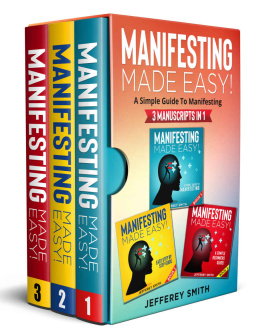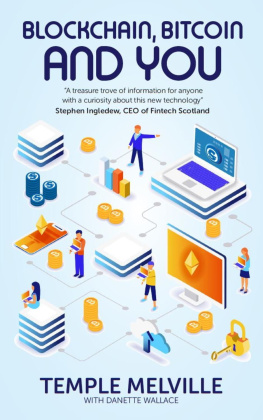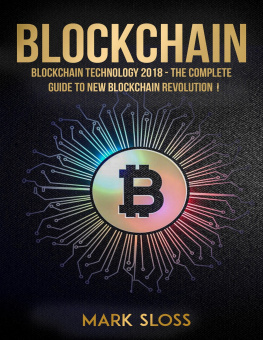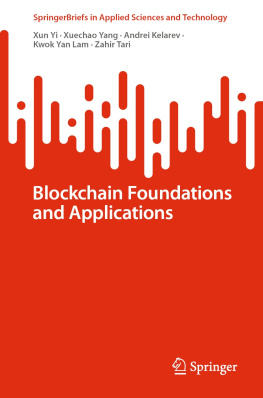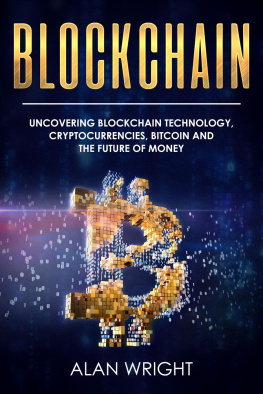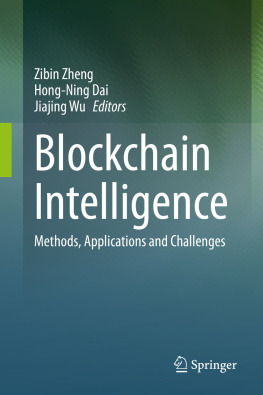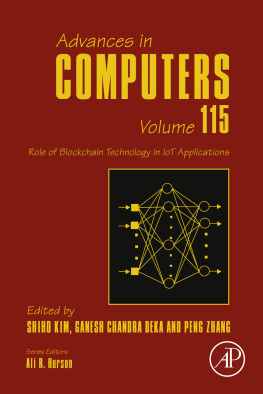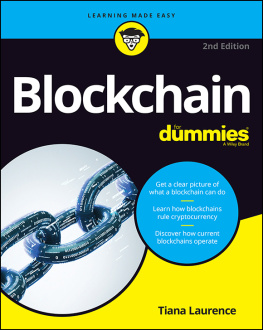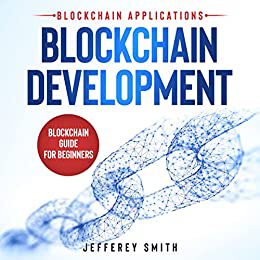Blockchain DevelopmentBlockchain Applications
Blockchain Guide for Beginners
Jefferey Smith
Copyright 2022All rights reserved.
The content contained within this book may not be reproduced, duplicated or transmitted without direct written permission from the author or the publisher.
Under no circumstances will any blame or legal responsibility be held against the publisher, or author, for any damages, reparation, or monetary loss due to the information contained within this book, either directly or indirectly.
Legal Notice:
This book is copyright protected. It is only for personal use. You cannot amend, distribute, sell, use, quote or paraphrase any part, or the content within this book, without the consent of the author or publisher.
Disclaimer Notice:
Please note the information contained within this document is for educational and entertainment purposes only. All effort has been executed to present accurate, up to date, reliable, complete information. No warranties of any kind are declared or implied. Readers acknowledge that the author is not engaged in the rendering of legal, financial, medical or professional advice. The content within this book has been derived from various sources. Please consult a licensed professional before attempting any techniques outlined in this book.
By reading this document, the reader agrees that under no circumstances is the author responsible for any losses, direct or indirect, that are incurred as a result of the use of the information contained within this document, including, but not limited to, errors, omissions, or inaccuracies.
Table of Contents
Introduction
When human beings lead a more nomadic life, there was no concept of ownership. There was no need to own anything because everything they needed to survive they either gathered or produced for themselves. And because of the nomadic nature of their lifestyle there was no need to own land or livestock. They moved around and lived off the land.
As time went on, they started to settle and grow their own crops. Once they started doing this there became a need to own the land that their crops grew on. There also was a need to own the apparatus they used to tend to these crops. Thus the concept of ownership was born.
As they continued to farm and produce fruits and vegetables, they would end up with more produce than they actually needed. They began to barter with each other. If one had more tomatoes than they needed and wanted spinach, they could exchange some of their tomatoes for some of someone elses spinach.
Eventually, they felt the need to record these transactions so they started writing to keep track of ownership. We can look at these writings as the first ledgers .
While they were moving in the right direction, they had a problem with trust. There was no way for them to verify the information contained in the ledgers because not everybody had access to them.
When banks eventually came around, people also had to trust them to keep their money safe, and that didnt always end well. There have been seven financial crises from the Great Depression to the Great Recession.
Some people started to realize that we needed a way forward that didnt see us relying heavily on other people. They saw that we needed a way to transact without fear or the constant threat of human error. Thus, Blockchain was born.
The overarching theme with Blockchain and Cryptocurrency is that you dont have to put your trust in an individual or a central authority to keep your assets safe. You dont even have to worry about breaches of contract or the integrity of any other party. Blockchain has the potential to ensure that most, if not all industries run more efficiently.
Blockchain Development
Blockchain Development is a novel career path. Because of this there are many opportunities you can take advantage of. A blockchain developer builds Decentralized Applications or DApps for short. DApps are programs that operate on a peer-to-peer network of computers as opposed to a single computer.
On a daily basis, a developer uses different programming languages to execute the code that designs user-interfaces, features and structures for blockchain applications. They are also responsible for putting security measures in place to avoid any attempts at hacking.
There are many self taught programmers and developers operating in the tech world today. It is possible to become a blockchain developer without a degree, but you would have to work extremely hard and possess the right skill set. If you plan on going about becoming a developer the traditional way, you will need:
At the very least, a Bachelors degree in computer science or IT.
Analytical expertise. A key part of development is working out what the customer needs and finding ways to achieve the best results with whatever infrastructure they have.
Coding skills. A thorough knowledge of various coding languages would be advantageous because it takes more than one to build a blockchain network.
Foundational knowledge of blockchain protocols. A protocol is an array of practices for sharing data from device to device. The only way devices can share information is if there is an aforementioned agreement stating how to structure it and how it will be sent and received. If there was no protocol, computer A could be sending data in 32-bit increments while computer B is expecting to receive data in 64-bit increments. The most prominent set of protocols is OSI or Open Systems Interconnection. It is a set of instructions on how all network interactions should be carried out between computers. Internet protocols you may recognize are: IP, HTTPS, and DNS.
Not every blockchain developer is going to have the same job specs because there are different positions one can hold, namely:
Blockchain Solution Architect
Solution Architects are responsible for everything technical during the sales process. They work closely with the sales head in devising solutions. They then lead a team of developers and eventually provide the solution to the customers.
Blockchain Quality Engineer
Quality Engineers supervise the development of blockchain applications and ensure that they are up to standard. Quality engineers are required to keep abreast of the newest blockchain features and developments.
Blockchain Project Manager
Project managers are more like overseers. They monitor and evaluate resources, supervise security protocols and transaction administration systems, compose distinct features and manage any operational issues on a blockchain network.
Blockchain Applications
When people think of the Blockchain, they almost immediately think of cryptocurrency, but it has other capabilities that could potentially involve Fiat money . Fiat money is tangible money. Fiat is Latin for let it be done. Money only has value because the government says so but it isnt backed by anything.
Applications include:
Money transfers
By cutting out the middleman, transferring money from person to person works out cheaper and is much quicker. Its convenient when transferring money across countries. Somebody in the United States can send money to the Dominican Republic in minutes.
Financial exchanges
The bulk of cryptocurrency exchanges on the blockchain used to happen from person to person. Now, different organizations are starting to offer decentralized cryptocurrency exchanges. These organizations have more control and can feel safe knowing that their transactions are secure.


